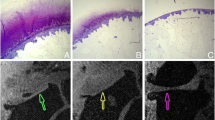Abstract
The objective of this study was to compare the value of multislice CT arthrography and MR arthrography in the assessment of cartilage lesions of the elbow joint. Twenty-six cadaveric elbow specimens were examined with the use of CT arthrography and MR arthrography prior to joint exploration and macroscopic inspection of articular cartilage. Findings at CT and MR arthrography were compared with macroscopic assessments in 104 cartilage areas. At macroscopic inspection, 45 cartilage lesions (six grade 2 lesions, 25 grade 3 lesions, 14 grade 4 lesions) and 59 areas of normal articular cartilage were observed. With macroscopic assessment as the gold standard CT and MR arthrography showed an overall sensitivity/specificity of 80/93% and 78/95% for the detection of cartilage lesions, respectively. Only two of six grade 2 lesions were detected by CT and MR arthrography. For the diagnosis of grade 3 and 4 lesions, the sensitivity/specificity was 87/94% with CT arthrography, and 85/95% with MR arthrography. In an experimental setting multislice CT arthrography and MR arthrography showed a similar performance in the detection of cartilage lesions. Both methods indicated limited value in the diagnosis of grade 2 articular cartilage lesions.







Similar content being viewed by others
References
Bauer M, Jonsson K, Josefsson PO, Linden B (1992) Osteochondrosis dissecans of the elbow. A long-term follow-up. Clin Orthop 284:156–160
Takahara M, Ogino T, Sasaki I, Kato H, Minami A, Kaneda K (1999) Long term outcome of osteochondritis dissecans of the humeral capitellum. Clin Orthop 363:108–115
Jackson DW, Scheer MJ, Simon TM (2001) Cartilage substitutes: overview of basic science and treatment options. J Am Acad Orthop Surg 9:37–52
Nehrer S, Minas T (2000) Treatment of articular cartilage defects. Invest Radiol 35:639–646
Ritsila VA, Santavirta S, Alhopuro S, Poussa M, Jaroma H, Rubak JM, Eskola A, Hoikka V, Snellman O, Osterman K (1994) Periosteal and perichondral grafting in reconstructive surgery. Clin Orthop 302:259–265
Ochi M, Sumen Y, Jitsuiki J, Ikuta Y (1995) Allogeneic deep frozen meniscal graft for repair of osteochondral defects in the knee joint. Arch Orthop Trauma Surg 114:260–266
Nakagawa Y, Matsusue Y, Ikeda N, Asada Y, Nakamura T (2001) Osteochondral grafting and arthroplasty for end-stage osteochondritis dissecans of the capitellum. A case report and review of the literature. Am J Sports Med 29:650–655
Hangody L, Kish G, Karpati Z, Udvarhelyi I, Szigeti I, Bely M (1998) Mosaicplasty for the treatment of articular cartilage defects: application in clinical practice. Orthopedics 21:751–756
Sato M, Ochi M, Uchio Y, Agung M, Baba H (2004) Transplantation of tissue-engineered cartilage for excessive osteochondritis dissecans of the elbow. J Shoulder Elbow Surg 13:221–225
Imhoff AB, Ottl GM, Burkart A, Traub S (1999) Autologous osteochondral transplantation on various joints. Orthopade 28:33–44
Hodler J, Resnick D (1996) Current status of imaging of articular cartilage. Skelet Radiol 25:703–709
McCauley TR (2002) MR imaging of chondral and osteochondral injuries of the knee. Radiol Clin N Am 40:1095–1107
Peterfy CG, Genant HK (1996) Emerging applications of magnetic resonance imaging in the evaluation of articular cartilage. Radiol Clin N Am 34:195–213
Disler DG, Recht MP, McCauley TR (2000) MR imaging of articular cartilage. Skelet Radiol 29:367–377
Waldschmidt JG, Rilling RJ, Kajdascy-Balla AA, Boynton MD, Erickson SJ (1997) In vitro and in vivo MR imaging of hyaline cartilage: zonal anatomy, imaging pitfalls, and pathologic conditions. Radiographics 17:1387–1402
Trattnig S, Mlynarik V, Huber M, Ba-Ssalamah A, Puig S, Imhof H (2000) Magnetic resonance imaging of articular cartilage and evaluation of cartilage disease. Invest Radiol 35:595–601
Gagliardi JA, Chung EM, Chandnani VP et al (1994) Detection and staging of chondromalacia patellae: relative efficacies of conventional MR imaging, MR arthrography, and CT arthrography. Am J Roentgenol 163:629–636
Gylys-Morin VM, Hajek PC, Sartoris DJ, Resnick D (1987) Articular cartilage defects: detectability in cadaver knees with MR. Am J Roentgenol 148:1153–1157
Kramer J, Recht MP, Imhof H, Stiglbauer R, Engel A (1994) Postcontrast MR arthrography in assessment of cartilage lesions. J Comput Assist Tomogr 18:218–224
Vande Berg BC, Lecouvet FE, Poilvache P, Jamart J, Materne R, Lengele B, Maldague B, Malghem J (2002) Assessment of knee cartilage in cadavers with dual-detector spiral CT arthrography and MR imaging. Radiology 222:430–436
Schmid MR, Pfirrmann CW, Hodler J, Vienne P, Zanetti M (2003) Cartilage lesions in the ankle joint: comparison of MR arthrography and CT arthrography. Skelet Radiol 32:259–265
Shahriaree H (1985) Chondromalacia. Contemp Orthop 11:27–33
VandeBerg BC, Lecouvet FE, Maldague B, Malghem J (2004) MR appearance of cartilage defects of the knee: preliminary results of a spiral CT arthrography-guided analysis. Eur Radiol 14:208–214
Cotten A, Jacobson J, Brossmann J, Hodler J, Trudell D, Resnick D (1997) MR arthrography of the elbow: normal anatomy and diagnostic pitfalls. J Comput Assist Tomogr 21:516–522
Putz R, Milz S, Maier M, Boszczyk A (2003) Functional morphology of the elbow joint. Orthopade 328:684–690
Ahrens PM, Redfern DR, Forester AJ (2001) Patterns of articular wear in the cadaveric elbow joint. J Shoulder Elbow Surg 10:52–56
Graichen H, Springer V, Flaman T, Stammberger T, Glaser C, Englmeier KH, Reiser M, Eckstein F (2000) Validation of high-resolution water-excitation magnetic resonance imaging for quantitative assessment of thin cartilage layers. Osteoarthritis 82:106–114
Schenck RC Jr, Athanasiou KA, Constantinides G, Gomez E (1994) A biomechanical analysis of articular cartilage of the human elbow and a potential relationship to osteochondritis dissecans. Clin Orthop 299:305–312
Author information
Authors and Affiliations
Corresponding author
Rights and permissions
About this article
Cite this article
Waldt, S., Bruegel, M., Ganter, K. et al. Comparison of multislice CT arthrography and MR arthrography for the detection of articular cartilage lesions of the elbow. Eur Radiol 15, 784–791 (2005). https://doi.org/10.1007/s00330-004-2585-9
Received:
Revised:
Accepted:
Published:
Issue Date:
DOI: https://doi.org/10.1007/s00330-004-2585-9




